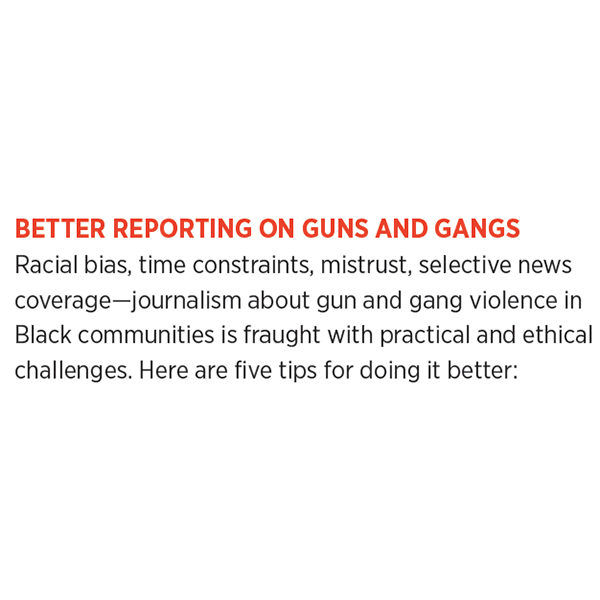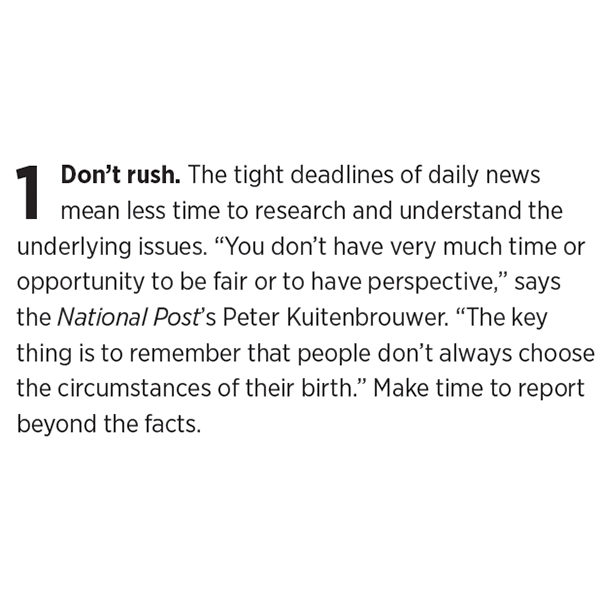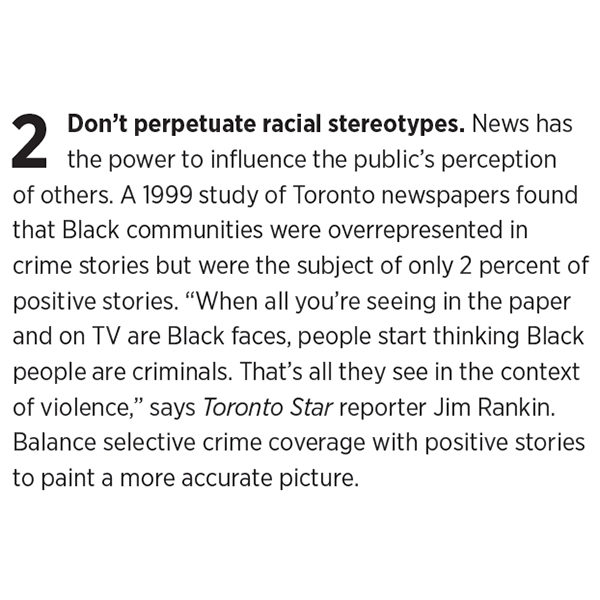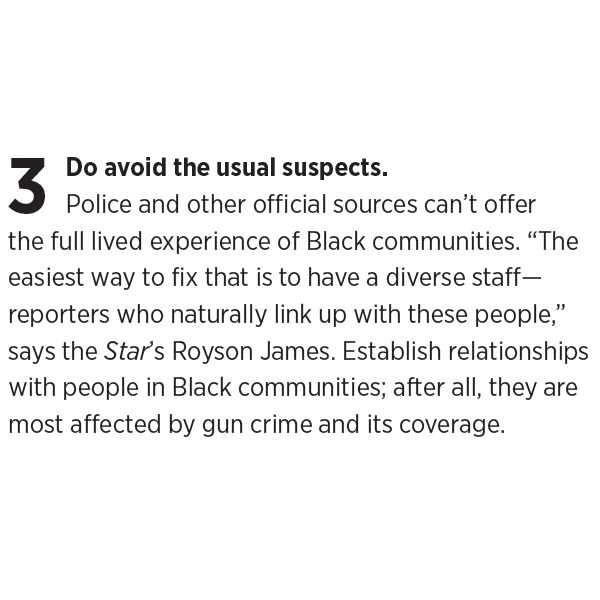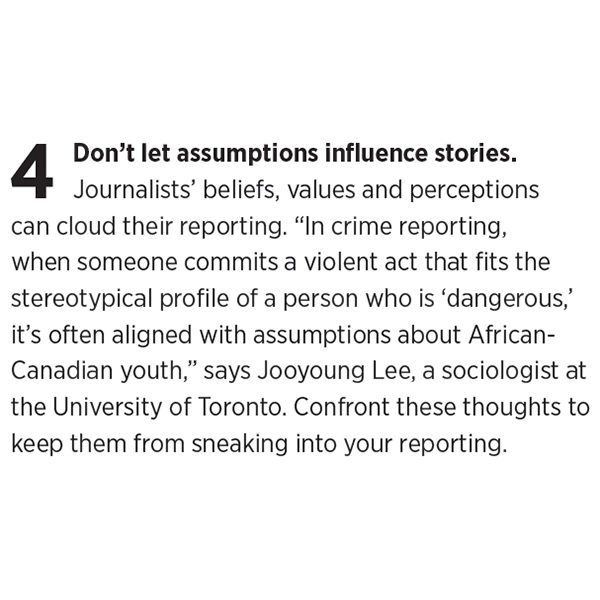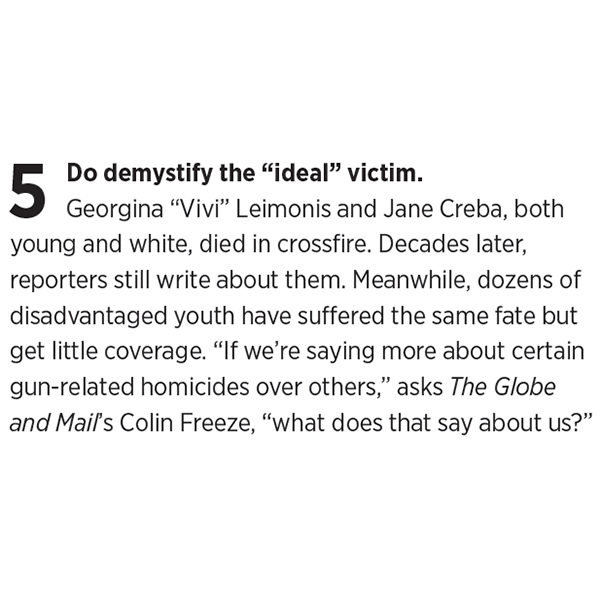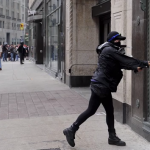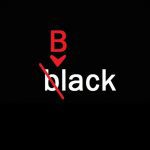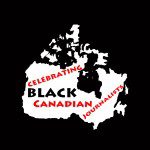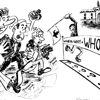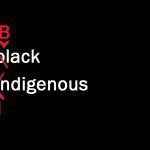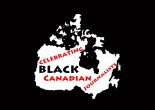Collateral Damage
Coverage of Toronto's gang and gun violence perpetuates a dangerous narrative that puts Black communities in the crossfire
“Oh my God/Oh my God/If I Die, I’m a legend,” shouted thousands of concert-goers through the haze of smoke and fireworks during the final song of Drake’s OVO Fest last August. For two people, those words foreshadowed the night ahead. As the three-day festival ended at Toronto’s Molson Canadian Amphitheatre around midnight, some excited fans tweeted on their way to the after-party at Muzik nightclub.
The Toronto Star later reported that Ariela Navarro-Fenoy couldn’t get tickets to the sold-out show, but she did get into Muzik. She reportedly texted a friend around 11 p.m. to let him know. Meanwhile, Duvel Hibbert also made it to the nightclub. Through- out the night, people posted on social media from the party, but around 3:30 a.m., journalists took over Twitter: shots had been fired at Muzik. On the club’s patio, Hibbert lay dead. Outside, Navarro-Fenoy had been hit by a stray bullet. By morning, both were dead, and three other people were injured. By the next afternoon, police formally released the victims’ names, but some journalists were already a step ahead.
The headlines reflected their findings: Navarro-Fenoy, who had an active social media presence, became the “beautiful, smiling” girl caught in a hail of bullets: “Drake fan was an innocent victim of Muzik shooting,” read a Star headline.
Hibbert received different treatment. A Google search for his name brought up a Canada-wide warrant issued by the Ontario Provincial Police in 2013 for his parole violation on a possession of a firearm offence. The Brampton Guardian titled an article “Muzik nightclub shooting victim had criminal record that included gun crimes,” and a Toronto Sun headline read: “Man slain at OVO Fest after-party was under house arrest.”
An online GoFundMe campaign for Navarro-Fenoy’s funeral costs surpassed its goal of $20,000. A campaign for Hibbert, started by someone identified as his sister Angie, collected less than $4,500. She begged people to look past the news stories about him—a life had still been lost.
The Muzik tragedy falls under one of Toronto’s biggest crime concerns: gun violence. While other cities have common crimes—stabbings in Regina and homicides in Winnipeg—gun homicides in Toronto get national coverage. The 2012 shooting at the Eaton Centre (followed by Danzig Street a month later), Yonge Street on Boxing Day 2005 and a Just Desserts café in 1994 represent the city’s gun problem.
The shooting deaths of youngsters Jordan Manners, Ephraim Brown, Kesean Williams and Lecent Ross also highlight the region’s issue with violent crime. While fatal shootings have dramatically decreased since Toronto’s “Year of the Gun” in 2005, shooting injuries—many involving young Black men from disadvantaged neighbourhoods—have increased. That worries the police and the public.
For years, media critics, lawyers and criminologists have denounced the coverage of gun violence, arguing that it perpetuates the stereotype that Black people, particularly Jamaicans, are violent gangbangers—Toronto’s obstacle to safe streets. In 2000, then-York University professors Frances Henry and Carol Tator analyzed two decades of English-language Canadian newspapers and found that reporters and editors not only contribute to the association of crime with Black people, but they also have the power to shape how the public views minority groups.
When Black shooters are easily identified, the crimes are “bloodbaths” that “spill” into Toronto streets, while others—like a January double murder in Toronto’s downtown Chinatown, which included three people injured on a busy nighttime street— are simply called “fatal.” In 2012, Christopher Husbands shot and killed two men in the crowded Eaton Centre food court, injuring four others. The shooting was called a bloodbath in some articles. Both the Star and the Sun described the Danzig barbecue as “Caribbean-themed” with “jerk chicken,” affiliating Black people with the shooting. Headlines and coverage involving Black shooters reflect sensational tones that spark fear of Black men and public panic about who is causing the shootings. And the focus on Black male shooters in high-profile cases and the underwhelming coverage of young Black victims suggest an implicit racial bias that, even in Toronto—known for its motto “Diversity our strength”—journalists fail to adequately address.
In the era of Black Lives Matter and a shift toward more diversity in newsrooms, journalists should be held accountable for how they report on crime when race is involved. They will have to learn to be sensitive to how their coverage can stigmatize an entire community. Such sensitivity is possible, but only if journalists are willing to report on the underlying issues.
Jamaicans started moving to Canada in large numbers throughout the 1970s and into the 1980s, and many settled in Toronto, where newspaper employees were—and remain—mostly white. Turf wars erupted in low-income neighbourhoods over the crack cocaine trade, mainly run by Jamaicans in the late ’80s and early ’90s. The city was fearful, and mainstream news outlets often lumped all Black people together when laying the blame. “It was terrible,” says former Sun reporter Tom Godfrey, who worked at Contrast, one of Toronto’s first Black newspapers, in the mid-’80s. He remembers being one of only a few Black reporters in the city. “You could be from Africa or Jamaica, but it was all ‘the Black community.’”
Meanwhile, Black leaders condemned police for beating and shooting people, including Albert Johnson in 1979 and Lester Donaldson and Michael Wade Lawson in 1988. “Young Black males were thrown into police cars and questioned later,” Godfrey says. “It was open season.”
He remembers dozens of Black people lined up outside the Contrast office to report alleged police beatings. Often, they’d have blood streaming from their faces. “They thought Black community papers would give them a fair shake,” he says, since mainstream news often sided with police.
News outlets began seeing a trend in gun violence: Jamaicans were often suspects and victims, and reporters fed the public’s anxiety about Jamaican crime taking over Toronto. Timothy Appleby, then a police reporter for The Globe and Mail, wrote a three-part series in July 1992 called “Crime: the Jamaica connection.” Each instalment started on the front page. The first of the series was headlined “Island crime wave spills over” and stated that “a small but volatile group of young Jamaican males has altered Toronto’s criminal landscape significantly in the past three years.” The pull quote in the full-page spread showcased the words of a law enforcement official in Jamaica: “The people who migrate are the riffraff. The quality ones stay home.”
The death of Georgina “Vivi” Leimonis, shot when three Jamaican men robbed a Just Desserts café, riveted Toronto in 1994. Described as an act of “urban terrorism” by police, the story ran repeatedly in the city’s major outlets. Newspapers published more than 200 stories on the murder in the following seven weeks. Editorials demanded tougher immigration laws, and an op-ed by the Globe’s Michael Valpy said the “barbarians are inside the gate” committing “alien slaughter.”
Globe reporter Peter Cheney says it was the most sensational murder case he’d seen in Canada, which he attributes to the growing racial tension between Black and white communities. “The Jamaican community in particular felt it was singled out for coverage that reflected poorly on it,” he says. “Was there actually a crime problem in that community? Was the media guilty of racist coverage? I think both were true.”
A late-’90s study of the Star and the Sun by criminologist Scot Wortley found that Black people appear predominantly in crime, sports and entertainment stories, while white people overpopulate politics, business and science. In 1999, not much had improved. Henry, then Ryerson University’s chair of diversity for the school of journalism, and research assistant Marnie Bjornson found that about 40 percent of all stories about Jamaicans in those two newspapers, between 1994 and 1997, were in relation to “social problems,” including crime and immigration, and only 2 percent were positive.
In 1999, Cheney finished “a.k.a. Brownman,” his in-depth fea- ture on Lawrence Brown, who was later convicted of first-degree murder in Leimonis’s death. Cheney says the case crystallized the white fear of Black men who, until then, the public believed were only killing each other in disadvantaged neighbourhoods. “But then it spilled over into the ‘privileged’ community—the white community,” Cheney says. “And a white person was shot while getting dessert. And so the two worlds had intersected.”
A decade later, the Jane Creba case also unnerved Toronto. On Boxing Day 2005, a stray bullet hit the 15-year-old during a gang shootout while she shopped on a busy downtown street. Detective sergeant Savas Kyriacou called it “the day Toronto lost its innocence.” Creba’s death ended the “Year of the Gun,” which led to the formation of the Toronto Anti-Violence Intervention Strategy (TAVIS) with $5 million from the province to create trained officer teams.
Wortley, now an associate professor at the University of Toronto Centre for Criminology & Sociolegal Studies, believes the case gained public sympathy because it was a “perfect storm.” It was an interracial shooting, and Wortley says that “Creba was what might be called the ‘ideal victim’: young, female, white, innocent, caught in gang warfare,” adding that people were also interested because it happened on Boxing Day in a busy Yonge Street shopping area. “Those crimes generate fear because it suggests that violence has stepped outside of its normal boundaries.”
Six weeks later, York University student Chantel Dunn was killed in a shooting the police said was meant for her boyfriend, who escaped with injuries. “It took place near Jane and Finch,” says Wortley, referring to one of Toronto’s well-known “priority” neighbourhoods, a euphemism for low-income areas. “The impression is if you’re unlucky or stupid enough to live in a high-crime area, then those types of things happen there, so it’s not a big story.”
Each year in his introductory criminology course, Wortley asks his students to make a list of famous Canadian criminals. They throw around names: Bernardo, Homolka, Pickton, Magnotta, Olson—all white. When he asks them which group they think is responsible for most violent crime in Canada, they say African and Aboriginal Canadians. Wortley challenges students to name one offender from either group, but nobody can. “It illustrates how white crime is individualized,” he says. The public learns about their childhoods, jobs and mental illnesses, even excuses for the behaviour. “But minority crime is a cultural phenomenon. It’s a problem in the neighbourhood. It’s a problem with Jamaicans. It’s hip hop culture,” he says. “Everybody in that group is stigmatized by it.”
Listen: Rob Lamberti, who covered crime at the Toronto Sun for almost 30 years, talks about the mistrust between Black communities and the Sun, and what the paper got wrong when reporting on crime involving Black people
White victims of gun crime in middle-class areas get thorough coverage, but Black victims rarely do. Often, this is because Black victims are shot in low-income neighbourhoods, far removed from public spaces and with few witnesses. Fifteen-year-old Jordan Manners, the first student killed by a gun inside a Toronto school, was an exception because the shooting took place during school hours. Wortley says if Manners had been shot in a plaza near Jane and Finch late at night, it would have never received the same amount of coverage or been investigated by a safety advisory panel.
Jooyoung Lee, a U of T sociologist who specializes in gun violence and hip hop culture, says there’s a psychological term called the “just-world hypothesis” that applies to victims of gun and gang violence. “It basically means that people reap what they sow. The things that happen to people tend to be deserved in some way,” he says, adding that there’s a public belief that Black youth shot in disadvantaged neighbourhoods must be gang members and drug dealers.
The vast majority of gunshot victims Lee has encountered in his research are regular people hurt in the crossfire—because they live in high-risk areas, get hit by a stray bullet or are victims of mistaken identity. “When these things happen in Black communities, we tend to think, ‘Oh, it must have been just another guy or girl who was caught up in a gang or caught up in street drug dealing.’”
Lee says that journalists’ own prejudices and biases subtly influence their stories, sending a message to the public about who is and isn’t dangerous. As an American living in Canada, Lee has seen the disparities in crime reporting on both sides of the border. “In the U.S., race and racial inequality are such a big part of discussions about gun violence and social inequality,” he says. “But there’s a tendency to talk about Canadian society as if it’s ‘post-racial’—as if issues about racial inequality are American problems.” Regardless, Lee says the stereotype remains the same in both countries. “There’s a fascination with the dangerous young Black male who is a thug.”
Audette Shephard believes young Black men aren’t hardened criminals, but boys growing up under oppressive circumstances. In June 2001, her only child, Justin Garth Shephard, was found dead on a footbridge half a kilometre from his home in North St. James Town, Toronto. He had been shot in the head. The 19-year-old was a popular and gifted athlete who planned to attend college in Maryland. A single mom, Shephard was close to Justin: they spoke in their own slang, she spoiled him with gifts, they would sometimes go to church together and, on his 19th birthday, he tattooed her name above his heart. His murder remains unsolved.
To find solutions to end youth gun violence, Shephard now sits on the board of the Attorney General’s Ontario Office for Victims of Crime. She is also a co-founder and chair of United Mothers Opposing Violence Everywhere. Shephard estimates she’s done hundreds of interviews with journalists, and when she talks about her son at schools, she sees past the hard shell of youth that reporters can’t seem to crack. “Some of these young men act so macho, and then at the end, they come up to me with tears in their eyes,” she says. “They give me a hug and say they’re so sorry.”
Stories that perpetuate the image of the young Black thug make it difficult for the public to see the human side of Black youth.
This February marked more than a year since Toronto police temporarily suspended the controversial practice of carding, which disproportionally targeted Black men. That month, the Sun published a column with the headline “Shootings up since carding suspended,” suggesting that gun violence is increasing because the people most often carded by police—Black men— are no longer stopped. Staff inspector Greg McLane was quoted in the Star saying that there are “many variables” contributing to gun violence.
After the Danzig shooting, the National Post published an article entirely about the Hennessy bought for the party, saying it has “a reputation as the go-to drink in hip hop circles” and is “popular among rappers.” Below the article is a list of lyrics about Hennessy by rappers Tupac Shakur, Snoop Dogg and Mac Dre, who all wrote about gang life in their music, and two of whom were killed by gunfire.
A Post story in July about Mark Moore, a Toronto rapper convicted of murdering four people, featured two screenshots of Moore from rap videos. In one, he’s wearing gold jewellery and pointing at the camera. In another, Moore is rapping in a limo, wearing sunglasses and gold chains and holding stacks of bills.
Paul Nguyen was so tired of seeing people’s expressions when he told them he lived at Jane and Finch that he started saying he lived in North York instead. He noticed that journalists came to the neighbourhood rarely—only when crimes occurred. So, after graduating from York University in 2004, he created Jane-Finch.com to dispel its negative image. “We have a lot of young people here doing amazing things, winning all kinds of awards, competing on national levels,” he says. “I wanted to share and promote those positive things here.”
Nguyen says reporters feed the perception that the neighbourhood is dangerous. A TV reporter approached him to do a story on young people using music to escape gang life. One of Nguyen’s friends, known for wearing a bulletproof vest, was helping out. The friend showed a reporter where bullets had been fired near a convenience store. The lead for the next day’s story: “Sometimes a simple trip to the corner store in Toronto’s Jane-Finch neighbourhood means wearing a bulletproof vest.”
The reporter was Black, so his angle particularly shocked Nguyen. Another time, reporters came to do a live hit for a positive story—and brought two men Nguyen believed were security guards. As Nguyen says, “Jane and Finch is a brand.”
The annual Toronto Caribbean Carnival, which used to be known as Caribana, is also a brand known for gunfire. Stephen Weir, public relations manager since 1999, says the public sometimes still calls it “Caribana” and, each year, the carnival ends up in the news for “pre-Caribana” or “Caribana weekend” crimes. Weir says many journalists don’t realize that club promoters use the name to help boost attendance at events that aren’t affiliated with the carnival.
In 2009, Wesler Fabien, a Black man from Ottawa, was shot to death outside the Howard Johnson Hotel in the posh Toronto area of Yorkville. Even though police said the shooting wasn’t related to the carnival, several articles included that it happened on carnival weekend and that Fabien and a friend were visiting the city to attend. “Good or bad,” Weir says, “Caribana is thought of as everything that happens on the August first weekend.” Sometimes, crimes are linked to the carnival weeks before it even begins. On July 23, 2010, a teenager was shot and killed at a church basement party in Ajax, about 50 kilometres east of Toronto. A Durham police officer was quoted saying, “We’ve been told that it was a pre-Caribana party.” Weir says the event had nothing to do with the carnival—it wasn’t even in Toronto.
In 2015, a stabbing took place during Nuit Blanche, an all-night art event; later that night, a crowd at Yonge-Dundas Square threw bottles at police. CityNews published an online article that reported, “Nuit Blanche was taking place at the same time although there were no installations at Yonge-Dundas Square.” Weir says, “If it had been a mostly Black or Caribbean crowd, it probably would have been called a ‘Caribana riot.’”
He says journalists rely heavily on police, who can use “throwaway lines” that end up sticking. If an officer incorrectly links a shooting to the festival, Weir has to call reporters to clarify. Although most journalists will issue a correction, he says some refuse or don’t follow through.
Reporters rely on crime information from police press conferences, which can’t give the full picture because they’re usually focused on a specific crime. “I think that police sometimes have a vested interest in creating moral panics about particular types of crimes because it can help mobilize public support,” Wortley says. In two decades as a criminologist, he’s seen public spending and police power increase dramatically after sensational shootings.
News outlets fed into this when they quoted former police chief Bill Blair’s statement labelling Danzig the “worst incident of gun violence in my memory anywhere in North America” as he stood at the scene. This statement is an example of why Wortley urges journalists to think hard about their sources. His op-ed in the Star the next day criticized Blair’s inaccurate statement about Danzig, in which two were killed, while pointing out that 14 people died in the Montreal Massacre and 32 were killed at Virginia Tech.
Journalistic accuracy is critical, and race-based data on crime could help journalists show a more accurate picture of crime in Canada. But, unlike American law enforcement, many Canadian cops don’t analyze it. Akwasi Owusu-Bempah, an assistant professor in the department of criminal justice at Indiana University (although he’s originally from the GTA), says the information could help journalists dispel stereotypes: “We rely on news media from the United States, so we vastly overestimate Black and other racial groups’ participation in crime,” he says. Wortley adds that the vast majority of all communities are actually law-abiding.
That’s what Star columnist Royson James wanted to show. “Yes, we have murders and gun violence and Black people are involved,” he says. “And a number of times it’s Jamaicans. So it’s going to get reported. You can’t sugarcoat that. The problem is that’s all that gets out there.”
James came to the city in 1969 as a poor teenager from rural Jamaica. He worked at Contrast before joining the Star in 1981, trying to prove himself as a well-versed reporter at a time when Black journalists were sparse. But he grew tired of seeing Black people—mainly Jamaicans—making headlines as criminals and gang members. “Why can we only focus on criminals of Jamaican descent? It’s the same criminals we all hate,” he says. “It blocks out everything else that the community does because it becomes the overriding narrative of a people.”
Jamaica’s 50th Independence Day on August 6, 2012, offered a golden opportunity to showcase positive stories. James suggested a series of articles, including following as many successful Jamaican-Torontonians as he could in 24 hours. His editor liked the idea, but said it would be difficult to do in that time frame without using already known people. James and six other reporters with Jamaican roots, including Donovan Vincent and Ashante Infantry, accepted the challenge. They followed 50 people, including a lawyer, a teacher, TTC operators, a dentist and a surgeon. “My editor said there were too many doctors,” says James. Too many doctors. “That was one of the best days of my journalism career.”
It was so unbearably hot when Peter Kuitenbrouwer woke on the morning of July 17, 2012, that the fire alarm in his house kept going off. But he didn’t have time to fix it. His editor at the Post needed him to get to Scarborough, in Toronto’s east end, fast: the breaking story was the Danzig Street shooting. Several weeks earlier, a shooting at the Eaton Centre killed two and wounded five others. This one, at a community barbecue in public housing, also killed two but injured 23.
Dozens of reporters crowded around the yellow tape. Mayor Rob Ford and representatives of Toronto Community Housing were there. Kuitenbrouwer wanted to go beyond the story that officials would give, so he went into the neighbourhood to talk to locals—but it wasn’t easy. “‘White guy from far away shows up and wants to stick his nose in our business.’ It’s usually that way,” he says. “It’s pretty hard to get trust.”
He picked up an extra meal for a resident at lunchtime, and the two ate outside together—a small way to ease the tension reporters cause by swooping into low-income neighbourhoods to report on a crime and then leaving, which, to Kuitenbrouwer, creates an “us versus them” relationship.
His article, “Life and death on ‘the other side of the tracks,’” made the front page. He says the time constraints of daily news make it difficult to report on underlying issues, but it’s essential to try, especially with a case like Danzig. “You go in thinking this is a horrible, dark place where people shoot each other,” he says. “But then you hang around for a while and realize it’s just people trying to get on with their lives but having some struggles.”
The Star’s Jim Rankin has written several features about the lives of young Black offenders and those affected by gun violence, including Audette Shephard. He thinks journalists still aren’t doing enough to present a balanced image of Black people. “Reporting on crime like it’s a sporting event is not getting beyond the surface,” he says. “All stories need to be told, whether they’re about the one who pulled the trigger or the one who died.” For Rankin, it helps to understand the systemic racism the Black community faces—contributing to a lack of opportunity, poverty, hopelessness and low-wage jobs, which, among other factors, make youth vulnerable to joining a gang or selling drugs.
In 2013, Star reporters David Bruser and Jayme Poisson did an investigative series about the guns smuggled into Toronto along U.S. Interstate 75—weapons that, they reported, were responsible for over 70 percent of the city’s shootings. The stories showed how lax gun-control laws in the United States made for easier gun access in Toronto—a root cause of street violence reporters rarely discuss.
James believes hiring journalists of colour could help newsrooms better understand these underlying causes, instead of relying on officials. “If your news team doesn’t have people who interact with members of the Black community except in exceptional cases of crime and violence,” he says, “then that’s all you’re going to get.”
Listen: Jeff Dvorkin, director of the journalism program at the University of Toronto Scarborough, talks about the importance of addressing race in reporting and how his students are creating the discussion in their classes
Godfrey says reporting on the Black community has greatly improved since he started at Contrast in the ’80s. He thinks social media and digital journalism allow people to gather different viewpoints and question news outlets’ intentions.
Questioning the intentions of journalists is fundamental to admitting that Canadian news has a race problem, but it doesn’t mean all outlets will be quick to address it. While many journalists report on the underlying issues of gun violence in Black communities, some don’t think race plays any role in crime reporting. By suggesting racial bias doesn’t exist, reporters lose the opportunity to educate themselves and their readers. They also lose the chance to help repair mistrust between journalists and Black communities, especially in Toronto, the city with the largest Black population in Canada. All it takes to start are a notepad and an open mind.
Video by Eternity Martis
Featured image by Gary Denness
Eternity Martis is the Spring 2016 multimedia editor at the RRJ. She currently writes for the Huffington Post and Vice Canada. Her work has also been featured on Canadaland, xoJane, and Salon.



